Fleet
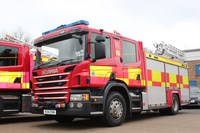
Scania light rescue pump
Light Rescue Pumps are the newest fire engines in the Service. We have nine of these at on-call fire stations and they look like a normal Scania fire engine but carry more equipment than a standard water tender, making them able to deal with some rescues. They hold 1,800 litres of water and equipment that firefighters use on a day-to-day basis, including hose reels and ladders, to help them deal with the majority of different emergencies. They are generally crewed by five firefighters. These fire engines have CCTV.
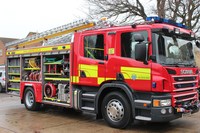
Scania rescue pump
The Service has six rescue pumps strategically located across the county. These look like a standard Scania fire engine but carry more specialist equipment to deal with rescue. They hold 1,800 litres of water and equipment that firefighters use on a day-to-day basis, including hose reels and ladders, to help them deal with the majority of different emergencies. They are generally crewed by five firefighters. They are located at Cambridge, Dogsthorpe, Huntingdon, St Neots, Ely and Wisbech. These fire engines have CCTV.
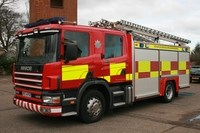
Scania water tender
This is a standard fire engine and also referred to as an appliance or a pump. It holds 1,800 litres of water and equipment that firefighters use on a day-to-day basis to help them deal with the majority of different emergencies. They are generally crewed by five firefighters.
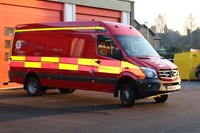
Rescue vehicle (RV)
We have two Mercedes Sprinter RV's stationed at Dogsthorpe and Cambridge. They are crewed by two firefighters and, as the name suggests, are called to incidents which require a more complex rescue such as water rescues and animal rescues.
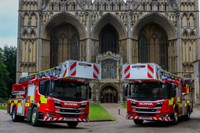
Turntable Ladder
We currently have two turntable ladders, one based at Stanground and one at Cambridge. The ladder can be extended to a height of 30 metres and can also be extended below the vehicle as well as up. Other features include a cage with a retractable access platform and connections for attaching a stretcher and a detachable thermal imaging camera. The camera can be mounted on the cage and can be live-streamed to officers and Combined Fire Control.
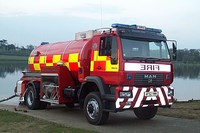
Water Carrier (WC)
The water carrier is crewed by on-call firefighters at Ramsey where it is housed and it contains 9,000 litres of water. This is used during incidents such as large fires which require a lot of water.
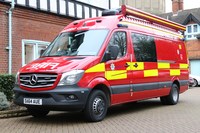
Incident Command Unit (ICU)
The Mercedes Sprinter ICU is a state of the art command and control vehicle, and is sent to incidents for incident commanders to work from to coordinate the firefighting or rescue operations. It contains computers, cameras and a secure satellite connection. It is also equipped with a canopy with an outside smart board for multi-agency briefings. The ICU is based at Huntingdon and is crewed by two on-call or wholetime firefighters.
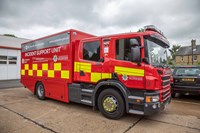
Incident Support Unit (ISU)
The ISU is based at St Neots and stores gas-tight suits and other equipment on board such as portable shower units and decontamination tents, to be used at incidents involving hazardous materials. It is crewed by either on-call or wholetime firefighters.
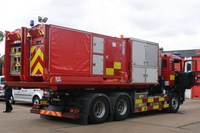
High Volume Pump (HVP)
Our HVP is housed at Cambourne and is crewed by two on-call firefighters. A crew from another on-call station is sent with the HVP to assist with setting it up. Firefighters at Cambourne and Gamlingay are trained to use the HVP. The HVP is used to pump large quantities of water to an incident, or it can be used to move large quantities of water away from an area such as in flood situations. The HVP has been provided by the department for Communities and Local Government (CLG) and is a national resilience asset.
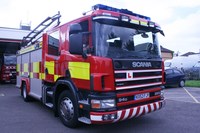
Driver trainer vehicle
We have two standard fire engines with L-plates on the front and rear. Firefighters undertake an intensive in-house training course before they can drive the fire engines. First they complete a five day Light Goods Vehicle (LGV) basic driving course and are assessed by an affiliated Driving Standards Agency (DSA) examiner. They must then drive a fire engine for six months or 600 miles on non-emergency journeys. They can then complete an Emergency Fire Appliance Driver (EFAD) course after which they are assessed and if they pass they can drive a fire engine to emergencies on blue lights.
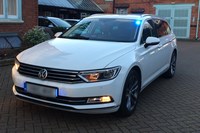
Officer cars
Our fire officers take the role of incident commanders at the scenes of property fires, RTCs and other significant incidents. They have special vehicles that look like civilian cars, but at the press of a button have blue lights and sirens for use when travelling to emergencies. Our fleet of officer vehicles are Volkswagen Passat and Golf cars. They use super bright LED technology fitted discretely to the lighting systems on the front and back of the vehicles, which flash when activated, along with sirens to alert the traffic.
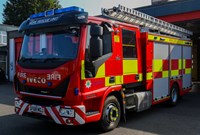
Rope Rescue Vehicle
The rope rescue vehicle carries our specialist rope rescue equipment. The appliance is based at Huntingdon fire station and crewed by wholetime staff who have received additional specialist training in rope rescue, working at height and supports incidents where extrication of casualties requires additional lifting and handling equipment.